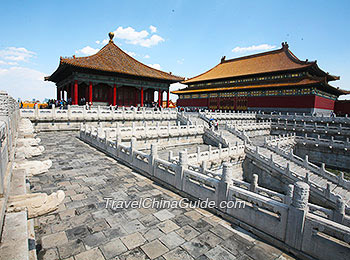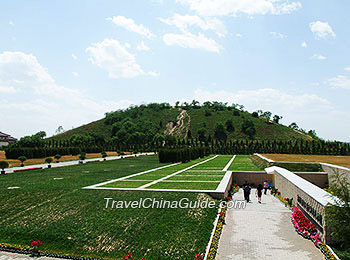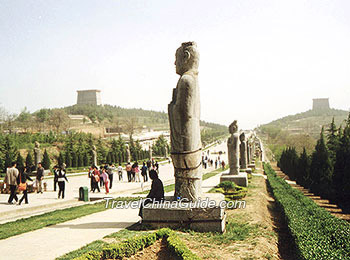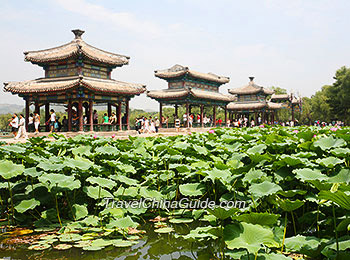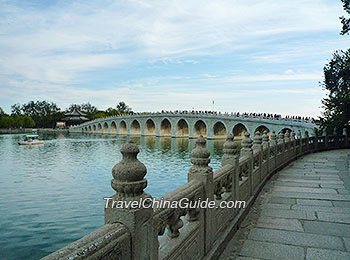Being an important component of the Chinese gorgeous culture, the imperial architecture
records the great intelligence and creation of the laborious ancient people that had a profound influence on the design of modern architecture at home and abroad. Generally speaking, it features the highest achievement of the Chinese ancient architecture that includes imperial palace, mausoleum and garden architecture.
Imperial Palace
The long Chinese feudal society saw the construction of numerous palaces, built to satisfy the emperors' extravagant lifestyles and protect the stateliness of their reign. Served as the venue where public affairs were dealt with and where the royal family lived, the construction of palaces emphasized on the splendorous appearance and regular layout. From the E'pang Palace of the Qin Dynasty (221BC-206BC), Weiyang Palace of the Han Dynasty (206BC-220) to the
Forbidden City of the Qing Dynasty (1644-1911), the scale of Chinese imperial palaces became larger and larger. Most of them are axial symmetrical, with splendid buildings standing at the middle axis and smaller attached houses located along both sides.
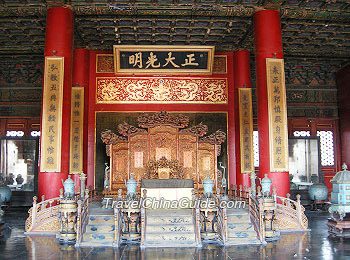 |
Inside the Palace of Heavenly Purity,
Forbidden City, Beijing |
The Forbidden City is a typical example. The general layout often follows two rules: the first being the ancestral temples must be situated at the front left of the main palace as the left is believed to be superior, while the front right was reserved for altars for praying to the gods of earth and grain. It is called 'Zuozu Youshe' in Chinese. The second being emperors handled national affairs at the palace's forecourt while the rear end was meant for living. In Chinese, this structure is called 'Qianchao Houqin'. Many distinctive characters were incorporated to indicate the imperial palace. For example, a pair of stone or copper lion often crouches in front of the main gate to ward off evil influence. Ornamental columns, carved with exquisite floral designs, soured into the sky. In the Forbidden City, auspicious jars filled with water were placed in front of the palace. They were not only decorative but also serve as fire-extinguishers. Because of this important function, they were nicknamed 'Menhai', the sea of the front door.
Related Link: Architectural Characteristics of Forbiden City
Imperial Mausoleum Architecture
It is another important component of Chinese imperial architecture, revealing the imposing majestic manner of royalty. Chinese emperors hoped to continue their luxurious imperial life after death. Stately mausoleums hence were built to satisfy their greed. Many were built with a sacred pathway before the tomb and at the underground palace. How they were been built were very much dynasty-influenced, especially the economy, social ideology and taste of the period then. For instance, before the Western Zhou Dynasty (11th century BC-771BC), coffins with exterior wooden enclosure were popular. The Qin and Han Dynasty emphasized very much on large scales and hence, many imperial tombs were built into an earth pyramid with a wide base.
Emperor Qin's Tomb is a typical representation of this. The
mausoleum of Emperor Taizong of Tang Dynasty,
Zhao Mausoleum features the characteristics of mausoleum style during the Tang Dynasty, which was to set it against a mountain. The Qing Dynasty is the glorious period in the history of Chinese ancient mausoleum as it added the idea of the harmonious unity of mausoleum construction with nature. The
Eastern Qing Tombs, the largest tomb complex in China, is worth visiting if exploring the mausoleum culture of the Qing Dynasty interests you.
Imperial Garden Architecture
It mainly has three characteristics: stylish, super splendor scales and harmonious unity of human with nature. Among the countless amazing gardens of the Tang Dynasty (618-907), the most significant one is the Huaqing Palace, where the romantic story of Emperor Xuanzong and his concubine Yangyuhuan took place. A number of fine halls and pavilions were erected, rows upon rows, along Lishan Mountain dotted with beautiful flowers. It is indeed an elegant sight during sunset. More functions were added to the imperial gardens in the Qing Dynasty. Emperors were not satisfied by merely living and playing in gardens. They made gardens venues for theatre-going and praying. Big and small picturesque gardens were just like precious stones dotted about. Summer Palace, one of the four famous gardens in China, symbolizes the highest achievement of the imperial garden during the Qing Dynasty. The present famous gardens also include: Beihai Park in Beijing and The Mountain Resort of Chengde.
- Last updated on Aug. 08, 2022 -
